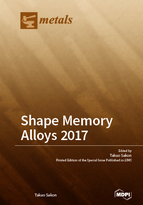Shape Memory Alloys 2017
A special issue of Metals (ISSN 2075-4701).
Deadline for manuscript submissions: closed (31 July 2017) | Viewed by 89419
Special Issue Editor
Interests: magnetism; shape memory alloys; magnetic actuators
Special Issues, Collections and Topics in MDPI journals
Special Issue Information
Dear Colleagues,
Shape memory alloys have attracted a great deal of attention due to their attractive properties for applications, as well as their basic aspects of deformation and transformation in structural and magnetic behavior. In 1951, the Au–Cd alloy was discovered. After that, countless shape memory alloys have been developed. A number of applications for shape memory alloys were realized after the Ti–Ni alloy was found in 1963 and developed extensively in 1980s. Recently, ferromagnetic shape memory alloys (FSMA) have been studied as candidates for highly functional materials. Among all the FSMA, Ni2MnGa is the most renowned alloy. New alloys in the Ni–Mn–In, Ni–Mn–Sn and Ni–Mn–Sb Heusler alloy systems that are expected to be ferromagnetic shape memory alloys have been studied. A re-entrant magnetism was observed in some alloys. These alloys are promising as a metamagnetic shape memory alloys with a magnetic field-induced shape memory effect and as magnetocaloric effect. Consequently, these materials are finding use or are candidates as materials for sensors, actuators, magnetic refrigerator, etc.
The Special Issue will be constructed articles reporting new and progressive research results, as well as reviews of particular classes of fundamental physics of the materials and their applications. Manuscripts will be welcomed from both fundamental scientific researchers and authors belonging to industrial companies involved in the field.
Prof. Dr. Takuo Sakon
Guest Editor
Keywords
- ferromagnetic shape memory alloys
- itinerant electron magnetism
- pre-martensite transformation
- superelasticity
- magneto-caloric effect
- thin SMA film
- magnetic field stress
- spectroscopy (Neutron, X-ray, Muon, Raman, photoelectron)






